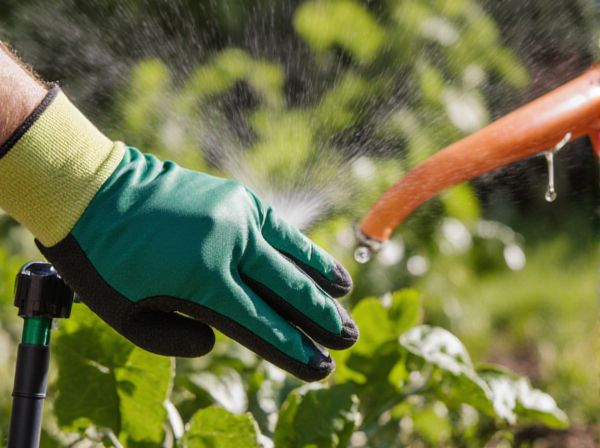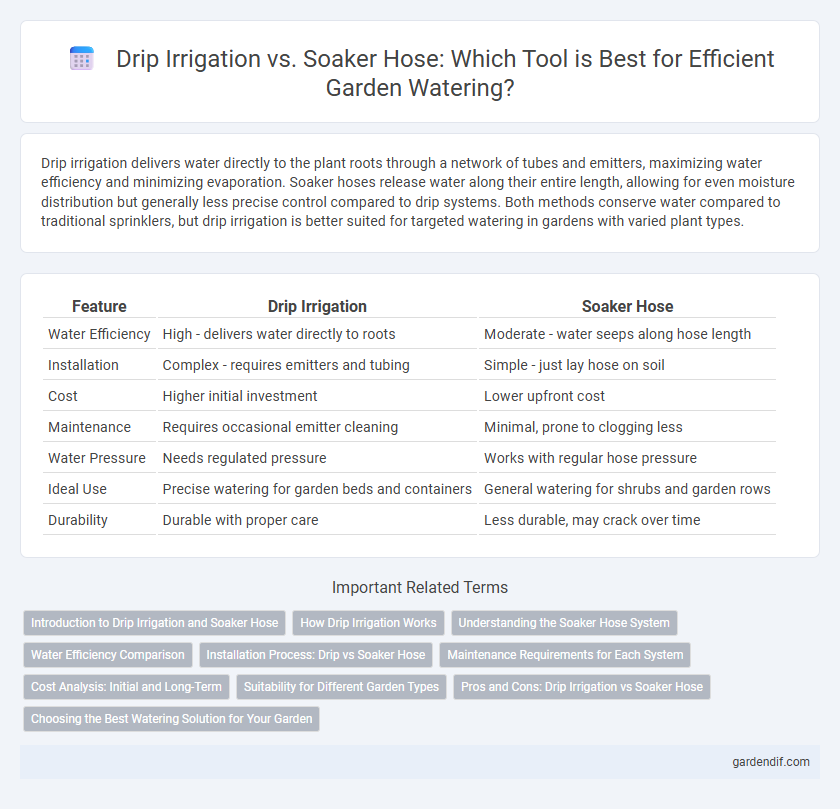
Drip irrigation vs soaker hose Illustration
Drip irrigation delivers water directly to the plant roots through a network of tubes and emitters, maximizing water efficiency and minimizing evaporation. Soaker hoses release water along their entire length, allowing for even moisture distribution but generally less precise control compared to drip systems. Both methods conserve water compared to traditional sprinklers, but drip irrigation is better suited for targeted watering in gardens with varied plant types.
Table of Comparison
| Feature | Drip Irrigation | Soaker Hose |
|---|---|---|
| Water Efficiency | High - delivers water directly to roots | Moderate - water seeps along hose length |
| Installation | Complex - requires emitters and tubing | Simple - just lay hose on soil |
| Cost | Higher initial investment | Lower upfront cost |
| Maintenance | Requires occasional emitter cleaning | Minimal, prone to clogging less |
| Water Pressure | Needs regulated pressure | Works with regular hose pressure |
| Ideal Use | Precise watering for garden beds and containers | General watering for shrubs and garden rows |
| Durability | Durable with proper care | Less durable, may crack over time |
Introduction to Drip Irrigation and Soaker Hose
Drip irrigation delivers water directly to plant roots through a network of tubes, emitters, and valves, optimizing water efficiency and minimizing evaporation. Soaker hoses are porous hoses that release water slowly along their length, providing even soil saturation without runoff. Both methods conserve water compared to traditional sprinklers but differ in precision and installation complexity.
How Drip Irrigation Works
Drip irrigation delivers water directly to the plant roots through a network of tubing, emitters, and valves, ensuring precise moisture control and minimizing water waste. This system releases water slowly and consistently, allowing for deeper soil penetration and improved nutrient absorption. Unlike soaker hoses that release water along their entire length, drip irrigation targets specific plants individually, enhancing efficiency for diverse garden layouts.
Understanding the Soaker Hose System
A soaker hose system delivers water slowly and directly to plant roots through porous material, minimizing evaporation and runoff. Its design allows for even moisture distribution along the hose length, making it ideal for garden beds and row crops. Compared to drip irrigation, soaker hoses require less installation effort and no specialized emitters, offering a cost-effective and straightforward watering solution.
Water Efficiency Comparison
Drip irrigation delivers water directly to plant roots with minimal evaporation, achieving up to 90% water efficiency, while soaker hoses release water more broadly, resulting in about 75-80% efficiency due to surface runoff and evaporation. Drip systems allow precise control over flow rates and timing, optimizing water usage in drought-prone areas. Soaker hoses, though simpler to install, generally use more water for less targeted irrigation, making drip irrigation the preferred choice for water conservation.
Installation Process: Drip vs Soaker Hose
Drip irrigation systems require precise installation involving emitters, tubing, and pressure regulators to ensure targeted water delivery, demanding more setup time and technical knowledge. Soaker hoses offer a simpler installation process, generally laid out directly on the soil surface or beneath mulch, making them ideal for gardeners seeking quick, low-maintenance watering solutions. Both systems benefit from connection to timers for automated watering, but drip irrigation offers greater customization in zone control and flow rates.
Maintenance Requirements for Each System
Drip irrigation systems require regular inspection and cleaning of emitters and filters to prevent clogging caused by mineral deposits or debris. Soaker hoses need periodic flushing to remove sediment buildup and occasional replacement due to material wear and UV damage. Both systems benefit from seasonal checks to ensure optimal water flow and longevity.
Cost Analysis: Initial and Long-Term
Drip irrigation systems generally have a higher initial cost due to the need for emitters, tubing, and pressure regulators, while soaker hoses are more affordable upfront and easier to install. Over the long term, drip irrigation offers greater water efficiency, reducing water bills and promoting healthier plant growth, which can offset the initial investment. Soaker hoses may incur higher water usage costs and require more frequent replacement due to wear and clogging.
Suitability for Different Garden Types
Drip irrigation systems provide precise water delivery suitable for vegetable gardens, raised beds, and container plants by targeting root zones with minimal waste. Soaker hoses excel in watering dense flower beds and established shrubs through slow, uniform seepage along their length. Gardeners should consider soil type, plant spacing, and garden layout to determine the most efficient watering method for their specific garden environment.
Pros and Cons: Drip Irrigation vs Soaker Hose
Drip irrigation provides precise water delivery directly to plant roots, reducing water waste and minimizing weed growth, but requires a more complex setup and higher initial costs. Soaker hoses offer an affordable, easy-to-install solution that evenly distributes water along their length, yet can suffer from issues like clogging and less control over water distribution. Both systems improve water efficiency compared to traditional sprinklers but vary in durability, maintenance needs, and suitability for different garden sizes and plant types.
Choosing the Best Watering Solution for Your Garden
Drip irrigation systems deliver water directly to plant roots through a network of tubes and emitters, maximizing water efficiency and reducing evaporation compared to soaker hoses, which release water along porous tubing laid on the soil surface. Soaker hoses are easier to install and typically less expensive but may lead to uneven water distribution and increased surface evaporation in hot climates. Selecting the best watering solution depends on garden size, plant type, water conservation goals, and ease of maintenance, with drip irrigation preferred for precision and sustainability.
Drip irrigation vs soaker hose Infographic

 gardendif.com
gardendif.com